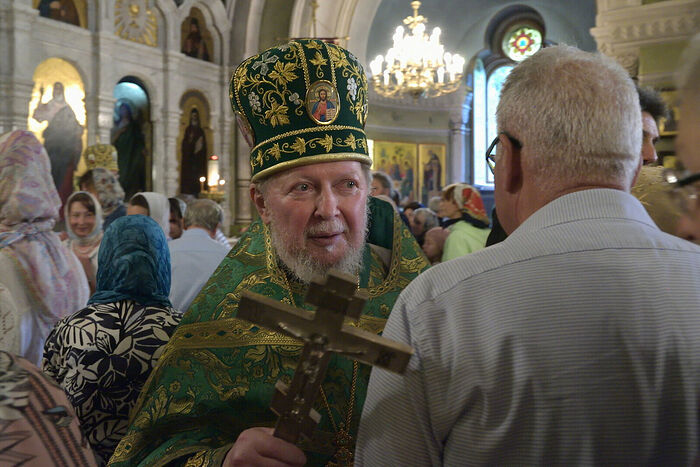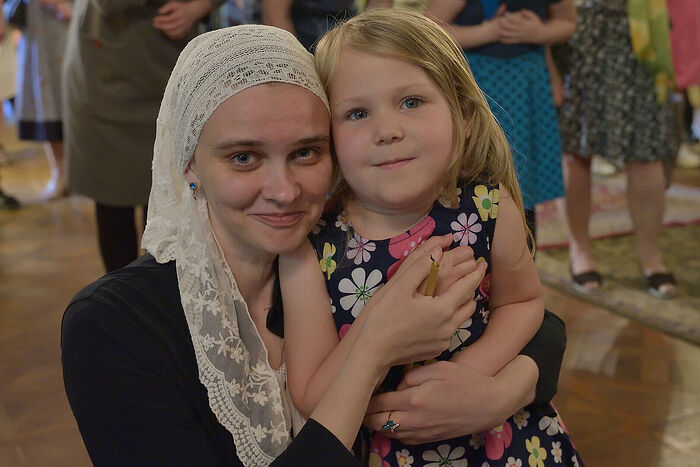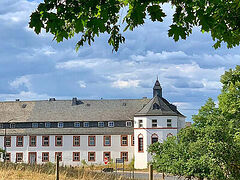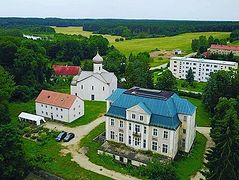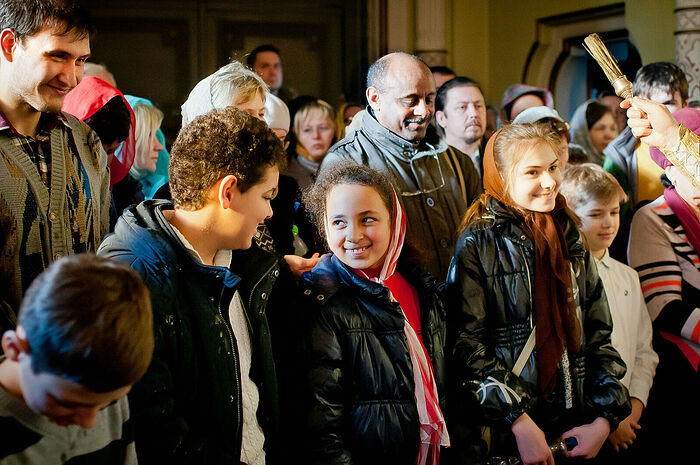 Parishioners of the Church of St. Simeon Stylites the Younger of Wonderful Mountain in Dresden
Parishioners of the Church of St. Simeon Stylites the Younger of Wonderful Mountain in Dresden
There are four things that amaze you at the Church of St. Simeon Stylites the Younger of Wonderful Mountain in the capital of Saxony. First, the number of parishioners is striking—the church is packed at a typical Sunday service. Second, there is no fuss or jostling because most parishioners have prayer-books in Russian or German in their hands—everyone is following the service closely. Third, the heroic calm and self-control of the rector, Fr. George Davydov, when he is reading a sermon despite children literally hanging onto his arms, crawling under his feet, pulling on the edges of his vestments. Fourthly, the general friendly atmosphere and smiles.
I couldn’t help but note critically: There were traces of burning candles that had fallen on the parquet on the south side near the candlestand. I thought, “They should have cleaned it up!” But I decided to show leniency. Besides, Deacon Roman Bannak offered to tell me more about the church, the parish and about the story of the “mess” that had outraged me. This is what Fr. Roman told me:
 Deacon Roman Bannak, photo by Maria Schmidt
Deacon Roman Bannak, photo by Maria Schmidt
There was an Orthodox community in Dresden even before the church appeared—at the beginning of the nineteenth century. Dresden is the capital of Saxony, and there were embassies and representative offices of various European states, including Russia. And in the early nineteenth century an event occurred that contributed to the rapid growth of the Orthodox community. After the Battle of Dresden on August 30, 1813, Russian, Prussian and Austrian troops entered the city. Thus, the capital of Saxony was under Russian administration, and it was from those military personnel and diplomats that a large Orthodox community was formed in the city. Very soon the strong community had an opportunity to build this magnificent church: one of the parishioners, Privy Councilor Semyon Vikulin, who worked at the Embassy, was the main sponsor of the construction, and other people donated as much as they could. And Harald Julius von Bosse, an architect from St. Petersburg, made drawings for the church for free. So the church was mainly built with donations from parishioners—only a seventh of the funds for construction went “through the official line”—from the Russian throne, but the rest of the funds were contributed by parishioners themselves. Construction began in 1872. Two years later the church was consecrated, and regular services have been held here almost uninterruptedly ever since.
At one time, Fyodor Mikhailovich Dostoevsky was a member of our community. His daughter Liubov was baptized here. And the diaries of the writer’s wife contain, among other things, a detailed description of the house church, which was the predecessor of this one, with memories of how Dostoevsky used to pray diligently here. That is, the writer was attracted not only by the famous Dresden Old Masters Picture Gallery, which, according to the memories, he visited almost daily.
Pyotr Arkadyevich Stolypin, the future great Russian statesman, was born and baptized here, in Dresden. The community is grateful to Sergei Vasilyevich Rachmaninoff not only for his wonderful music, but also for his large donation of coal, thanks to which the church was able to survive during the hungry and cold years.
 The Church of St. Simeon of Wonderful Mountain. Photo: Azbyka.ru
The Church of St. Simeon of Wonderful Mountain. Photo: Azbyka.ru
The local society has always helped our church—the Saxons love Russia. The church was almost never closed, even in the most terrible times. The only exception was the First World War, when, by order of the Dresden police, the church was temporarily sealed. The reason was explained quite naively and simply: “Since we do not understand the Orthodox liturgical language, it is not clear for whose victory of arms prayers are offered up here.” We could only respect the Dresden police—they apparently believed so much in the power of church prayer that they even closed the church out of fear! But otherwise, even in the Third Reich, despite all sorts of difficulties, the church remained open and prayer did not cease here. The Nazis tried to play on the differences in the political views of emigres and refugees from Russia. They wanted to win them over, but nothing came of it.
In the GDR, the backbone of the church community was... the Soviet military. Despite their political indoctrination, soldiers and officers, including those of the highest ranks, attended services and prayed here. This does not mean that the military came here in companies or regiments, but a significant minority of the officer corps were regular parishioners.
In the GDR, where the Church was not persecuted as harshly as in the USSR, it was viewed rather as a “cultural heritage”: singers of the famous Semperoper, the oldest opera house in Germany, would be sent here, to the church, to practice. However, those singers understood little about church matters; they would be given printouts of the service in the Latin alphabet, sheet music, and they sang. But even this method helped preserve the liturgical life of the church. By the way, I am not sure that all the choristers of the Soviet Union, who sang liturgical music at that time, understood what the works of Rachmaninov or Bortnyansky they performed were about.
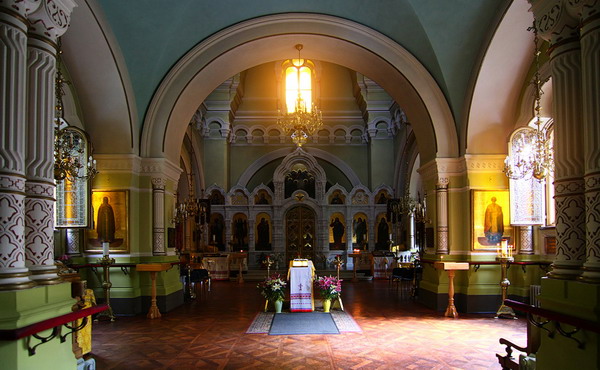 The interior of the church. Photo: Putnik.cerkov.ru
The interior of the church. Photo: Putnik.cerkov.ru
For many, especially those who come from Russia, the church interior is not particularly magnificent. The current community is not rich—a typical story for a Russian parish abroad. It should in addition be taken into account that we rent the premises from ROCOR, and any work, any initiatives to decorate or clean up the church require long coordination not only with the owner, but also with departments and organizations for the protection of architectural and cultural monuments. The bureaucracy is terrible. Therefore, it is very difficult to solve any issue promptly.
But, in my opinion, the most important thing is not financial well-being. However, not only in my own, but also in our common opinion, it is much more precious to us that the church community is united, that people are always ready to help each other and those who are near and distant. And the atmosphere here is so familial and kind. You just heard a young lady say, “Thank God that I can go here—to this church!” Many people think so, I know. If there were divisions and bitterness, we wouldn’t have hundreds of parishioners, right? Children literally hang on Father George like Christmas tree toys—he no longer resists, although he is seventy. Would it be like this if the community were not closely-knit?
And the community is growing—more and more young people are coming to the church. What makes me glad is that they aren’t coming here “as a tribute to tradition”, but at the call of their hearts, striving to really understand Orthodoxy, church services; and they take it seriously. They often stand at the service with the text of the Liturgy, “I must understand what it’s about. I want to know the service!” they say. Such a serious, respectful attitude is very encouraging. Of course, we have a Sunday school, catechism classes, and other meetings. So, thank God, there is much to do.
There are also Germans. Not those who just “came to listen to the singing”, but those who are really seeking Christ. Some of them (forgive me, dear Germans!) first were brought here by their spouses—Russian “myrrh-bearing women” of our days—and, seeing the beauty of Orthodoxy, remained in the church. And others joined as a result of a long and painful intellectual search, reflections and torments. Then they travel to monasteries, come back, tell us about their experience and think again. Well, let them think and read.
There are also Serbs, Georgians and Ukrainians—a lot of them. By the way, we didn’t even know who was Russian and who was Ukrainian before all these sad events—no one cared who you were. We pray that we will return to such a “saving indifference”. Judging by the fact that there are no conflicts, thank God, the Lord hears our prayers, and the church can really be called a house of peace. We really hope that it will be so. In fact, what difference does it make to Fr. George which child has perched on him—a Russian, Ukrainian, Serbian or German? In any case it’s heavy. So probably it is not easy for God with all of us.
Though anything is possible. Some people called to wish that we all “burn in hell” (some Protestant clergy from western Germany showed such “humanity”). There were also acts of vandalism—the church was desecrated… But the situation is still not too bad in Dresden—in Leipzig or Berlin, and especially in the western part of the country, it’s worse.
But we are convinced that Christ will not abandon us. We have examples of His help that saves human lives. You complained there were traces of burning candles on the floor, and it’s time to replace this floor, right? I will tell you that these traces are already seventy-eight years old, and these “candles” were lit by British and American bombers. During that fateful and terrible bombing of Dresden, which destroyed the city in February 1945, over 200 people from all over the neighborhood were saved in the basement of this church. The priest was upstairs, praying. Actually, everyone was praying. An incendiary bomb flew through the window: the priest seized it with his bare hands and threw it out into the street. His hands were scorched, but both the people and the church were saved. You may have noticed that all the buildings in the area where our church stands are modern. And it is clear why—the former buildings were razed to the ground. All of them—except for the Church of St. Simeon of Wonderful Mountain. And all the people who were in the church were saved. And I believe that if Christ then saved the people who found refuge from hell in the church, He will save us from the current hell. If only we can remain with Him.

